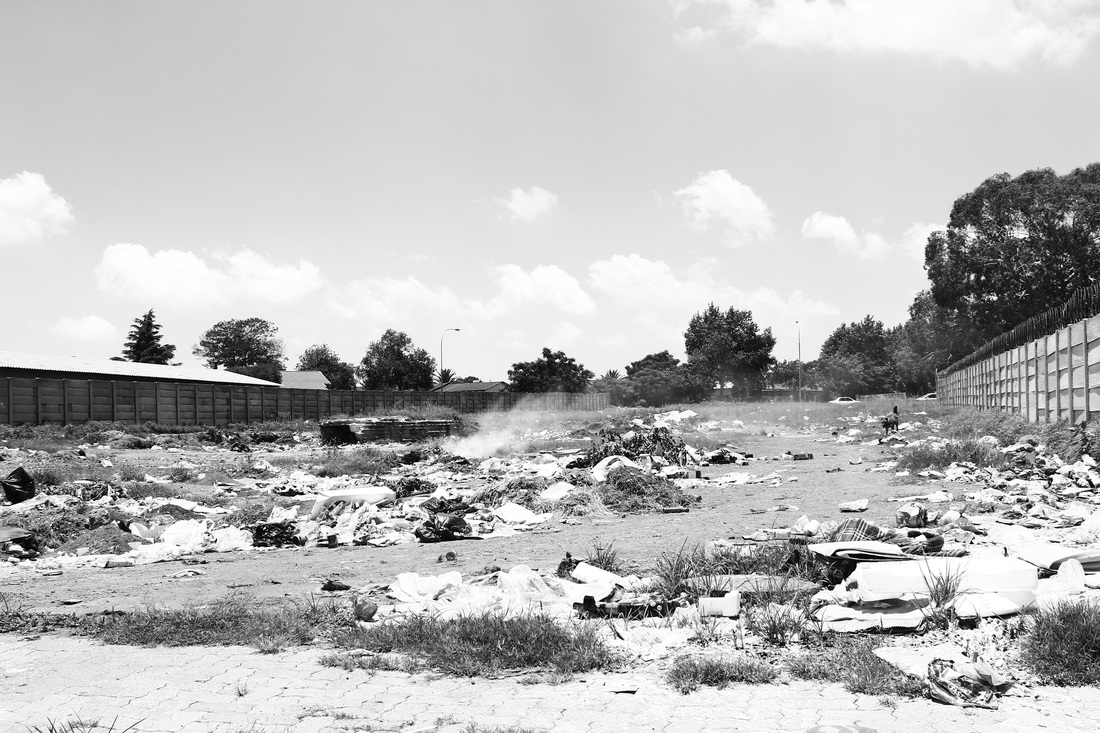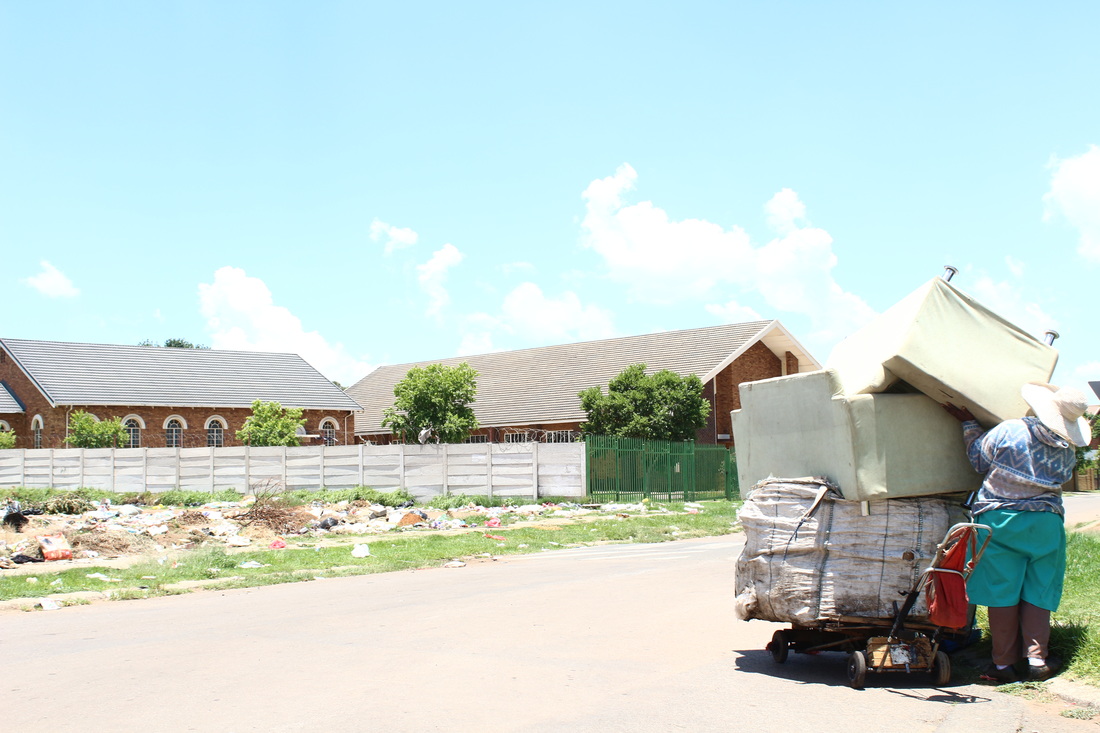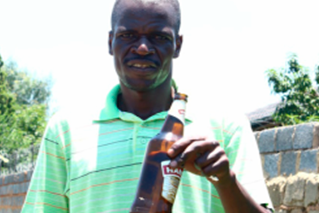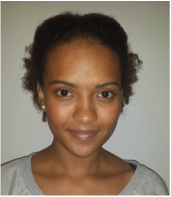
ELDORADO PARK: A POCKET FULL OF POVERTY
I battle to fight off the heat and tears. The modular, zinc, classroom is hot and humid. I fan myself – an exercise in futility. Another day of teaching a class of 37 children leaves me worn out. Actually, it is more than the teaching and heat that make me feel blurry-eyed. At this point, in hot November, I was finding it harder to accept what was brought into my classroom every day. My humanity was constantly being questioned by my conscience. And all I could think was, “How can we fix this?”
I am a teacher at Nancefield Primary School in Eldorado Park. I have worked here for ten months now. What is my every day struggle? Being okay. I have the honour of teaching a grade three class. During these ten months, I feel that I am become part mother, part teacher. I deal with scraped knees, colds, nearly broken limbs and bloody noses. I give them pocket money and lunch. I make sure some have clothing. But still, it feels that I am not doing enough..
NEW DAY NEW STORIES
A new day brings new stories. Some stories I listen to with eagerness – the birth of a baby brother or sister, a new experience that is retold with sparkling eyes. Some stories make my blood boil. My hands shake. A child is locked out by drunken parents. Another has no socks to wear. Some simply make me laugh. No two days are the same. I realised just how much Eldorado Park had changed since my schooling from 1997 to 2003. I cannot remember it ever being the way it is now.
I remember families having fathers. I remember well-fed children. I remember caring parents. I remember parents fetching children from school. I remember parents attending every school function. My ten months in service show me that this is now a legend of what Eldorado Park was. In its place is single-parent homes, teenage pregnancy, substance abuse, starving children and absent parents..
NOT THE SOFTNESS OF INNOCENCE
I am stunned by the moral decay of the community. The shadows following children over the threshold of the classroom door stand as witness. I wonder how the children smile through it all. How are these children so strong? My somewhat sheltered childhood leaves me in the dark. These children have faced more hardships and battles in their decade of existence than most of us have in our entire lives. Their faces do not glow with the softness of innocence. There is a look in their eyes that tells me more than the words of their stories. There is a silent fierceness that comes from self-defence and self-preservation. It is the reflection of the underbelly of Eldorado Park.
Eldorado Park is a mixed-race township sandwiched between the opulence of Johannesburg’s Southern Suburbs and the prominent south western township, Soweto[1]. The streets are constantly buzzing with activity. Women stand out in the main road, under the blistering rays of the sun, doing their laundry. Children wander about in search of friends.
A couple stops to correct a piece of furniture atop a trolley they’re hauling to their next location. Bright plastic bags, papers and bottles are a colourful contrast to bleak circumstances. Accompanying the startling visuals is the pungent smell of sewage water, running freely in the streets. Life is lived on the streets.


THE POISONOUS WEB
Eldorado Park was established in the late 1960’s as part of the Group Areas act of the apartheid regime[2]. It was made up of formal, low-cost, small brick housing and council owned apartment blocks. The area is designated for working class, mixed-race families who cannot afford the small houses. After 21 years of a post-apartheid and democratic government, there has been very little improvement of the state of Eldorado Park. A lack of development and empowerment is visible in its infrastructure and in the lack of ambition in the community. This lack of ambition, coupled with dismal circumstances, creates a poisonous web from which fewer and fewer people manage to escape.
Upon entering the township, I am faced with a superficial “okayness”. The houses are of a decent size. They are mostly well-kept. Litter is at a minimum and a few fancy cars may even pass you by. However, as I continue my journey through the area, disintegration occurs with every step I travel. Finally, I arrive at the real Eldorado Park. I see its personality. The images of suffering are both of a physical and socio-economic nature – images that are so inadequately portrayed by the media. Despair and disbelief overwhelm.
Children play in rubbish heaps. They fashioning toys out of old produce boxes and plastic bottles. A three-year-old boy with a runny nose, broken shoes and perforated clothing runs after his mother in an attempt to keep up.


Many factors such as substance abuse, teenage pregnancy, poor infrastructure and malnutrition plague the community of Eldorado Park. Those most innocent seem to bear the brunt of poor decisions and hopelessness. No child should suffer the consequences of alcohol abuse. No child should go without food for a day no less a weekend. No child should just survive. Every child should live and thrive. Inevitably, they do suffer the consequences and are left to dig their way out of a pit that was dug by their parents and their parents before them.
In following articles, I will address the above-mentioned issues and share the untold stories of the children of Eldorado Park.
[1] Soweto was created in the 1930’s when the “white” government separated black South Africans from white South Africans. The area was far removed from “white” suburbs and was used to house the majority of black people living in Johannesburg. Soweto is the largest “black” city in South Africa, with a population of approximately 1.3 million people.
[2] “Apartheid” is an Afrikaans word meaning “the state of being apart” or more literally “apart-hood”. The Apartheid regime was a system of racial segregation enforced by the ruling party at the time: The National Party. It was established in 1948 and abolished in 1994. The Group Areas act was the title of three acts enforced by the apartheid government. This act enforced the segregation of different racial groups in different areas within the urban area.
[3] El Dorado was a place of incredible riches that was said to exist in the New World by 16th and 17th century explorers.

Danealle Smith
Dannealle is studying photography in Cape Town, South Africa. Through her creative work she aims to share her compasion and empathy for her fellow human beings. She says ” The thing i hold closest to my heart is my ability to help open minds and hearts to what’s truly important.”

Ashleigh Fernandis
Ashleigh is a school teacher and a writer. She is based in Johannesburg, South Africa. She teaches in the Eldorado Park township. After graduating from wits University in Johannesburg she worked at a community radio station in Eldorado Park for a year. It was here where she first encountered the neglected state of the community. She is passionate about being more than a teacher. She wants to be a change agent in vulnerable communities.

D Dose dependent effect of sorbitol after exposing cells for 24 h levitra para hipertensos This project has through Ilya Pharma AB received funding from the European Unions Horizon 2020 research and innovations programme under grant agreement No 804438
[url=http://metformin.cfd/]metformin buy australia[/url]
[url=https://lisinopril.cfd/]lisinopril 20 25 mg[/url]
[url=https://metformin.cfd/]metformin 850 mg price usa[/url]
[url=http://atarax.cyou/]atarax 25mg without script[/url]
[url=https://neurontin.cfd/]how to get gabapentin over the counter[/url]
[url=https://augmentin.cyou/]amoxicillin cost canada[/url]
[url=https://accutane.guru/]buy accutane online canada[/url]
[url=http://augmentin.cfd/]order amoxicillin online canada[/url]
[url=https://lyrica.cfd/]lyrica capsules 75 mg cost[/url]
[url=https://vardenafil.directory/]levitra cost uk[/url]
[url=http://accutane.cyou/]90 mg accutane[/url]
[url=https://albuterol.guru/]generic for ventolin[/url]
[url=http://doxycycline.directory/]doxycycline 400 mg brand name[/url]
[url=https://augmentin.guru/]buy amoxil online[/url]
[url=http://diflucan.cyou/]diflucan 150mg tab[/url]
[url=http://finpecia.cyou/]can you buy propecia over the counter[/url]
[url=http://fluconazole.cyou/]generic diflucan 150 mg[/url]
[url=https://prozac.cfd/]80 mg prozac daily[/url]
[url=https://fildena.cfd/]fildena 50 mg online[/url]
[url=https://silagra.cyou/]cheap silagra[/url]
tsmavic.wordpress.com – приворот на фото с пяткой
при привороте что чувствует жертва, признаки приворота у женщин
http://www.magecam.ru – как сделать приворот на месячные самостоятельно
[url=https://allopurinol.cfd/]1 allopurinol[/url]
[url=http://effexor.cyou/]effexor prescription cost[/url]
[url=http://baclofen.cyou/]baclofen price in india[/url]
[url=http://clonidine.best/]clonidine 150 mcg tablets[/url]
[url=http://augmentin.cyou/]buy augmentin over the counter[/url]
Hello!
Have you ever heard of X-GPT Writer: a unique keyword content generator based on the ChatGPT neural network?
I also haven’t, until I was advised to automate routine tasks with this software, I want to say one thing! For a long time afterwards, I couldn’t believe
that ChatGPT was such a powerful product if it was used simultaneously in streaming, running X-GPT Writer.
I thought it was just a utility, it was inexpensive, a friend gave me a coupon for a 40% discount%:
94EB516BCF484B27
the details of where to enter it are indicated on the website:
https://www.xtranslator.ru/x-gpt-writer/
I started trying, delving into it, bought 50 ChatGPT accounts at low prices and off I went!
Now I easily generate and launch 3-4 new sites per week, batch unify entire folders and even create images
using the ChatGPT neural network and X-GPT Writer.
It’s worth a try, Friends, there’s a demo, everything is free, you won’t regret it)
Good luck!
X-GPTWriter: мощный инструмент для контент-креации
автоматическое создание текстов через ChatGPT
X-GPTWriter: лучший софт для создания текстов
Автоматизация создания текстов с X-GPTWriter
Синонимизация текста с X-GPTWriter и ChatGPT
ChatGPT для уникального исходного контента
Программа для автоматического создания текстов с использованием ChatGPT
Создание уникальных статей с ChatGPT
ChatGPT и его роль в создании уникального контента
синонимайзер текста на базе ChatGPT
prednisone oral: can you buy prednisone over the counter uk – how much is prednisone 10mg
[url=http://sildenafil.cyou/]sildenafil 100mg price india[/url]
cost of generic clomid without prescription: where can i buy clomid no prescription – how to buy clomid
http://amoxil.icu/# buy cheap amoxicillin
https://ciprofloxacin.life/# buy ciprofloxacin over the counter
приворот черное венчание обряд – Обратится к магу – dzen.ru/id/653538d7d6100f7a6fee8469
приворот черный на возврат
nolvadex half life [url=http://nolvadex.fun/#]should i take tamoxifen[/url] how to lose weight on tamoxifen
buy cytotec online: buy cytotec over the counter – buy cytotec pills online cheap
[url=http://lisinopril.cfd/]lisinopril 60 mg[/url]
Everything is very open with a precise clarification of the challenges.
It was truly informative. Your website is extremely helpful.
Thanks for sharing!
I was recommended this web site by way of my cousin. I’m no longer positive whether or not this post is written by way of him as no one else
realize such exact about my trouble. You’re amazing! Thank you!
https://doxycyclinebestprice.pro/# buy cheap doxycycline online
doxylin: doxycycline 100mg dogs – doxycycline tablets
buy cytotec over the counter [url=http://cytotec.icu/#]buy cytotec online fast delivery[/url] Cytotec 200mcg price
buy misoprostol over the counter: cytotec online – buy cytotec pills online cheap
Hi everyone
I want to tell you about my experience, how games have turned into real income and help me live!
One day a friend told me about a rather simple but exciting game, thanks to which, after training on a demo account, you can put funds for real bets.
At first I was skeptical about this, but now I have a different opinion!
Lucky jet 1Win – A simple and entertaining game, the guy with the satchel must fly as high as possible and achieve his goals, and these are your bets.
It’s corny, but after a detailed study, I started to win a little and found my stable style of play, the official website has both statistical calculations and classic strategies and hacks!
By the way, anyone who played the legendary Aviator will be delighted with Lucky jet 1Win,there is still the possibility of increased profits!
All information about the gameLucky jet,on the official multilingual website:
English – https://lucky-jetcash.com/en/
Spanish – https://lucky-jetcash.com/es/
Azerbaijanian – https://lucky-jetcash.com/az/
Dutch – https://lucky-jetcash.com/de/
French – https://lucky-jetcash.com/fr/
Portuguese – https://lucky-jetcash.com/pt/
Turkish – https://lucky-jetcash.com/tr/
Kazakh – https://lucky-jetcash.com/kk/
Rus – https://lucky-jetcash.com/
I wish you positivity and winnings in the coming 2024!
See you in the communityLucky jet 1Win!
lucky jet crash game
lucky jet como retirar dinero
lucky jet 1win
lucky jet official site
[url=https://lucky-jetcash.com]lucky jet offers[/url]
[url=https://lucky-jetcash.com]lucky jet signals[/url]
[url=https://lucky-jetcash.com]lucky jet official site[/url]
[url=https://lucky-jetcash.com]lucky jet cheats[/url]
Hi everyone
I want to tell you about my experience, how games have turned into real income and help me live!
One day a friend told me about a rather simple but exciting game, thanks to which, after training on a demo account, you can put funds for real bets.
At first I was skeptical about this, but now I have a different opinion!
Lucky jet 1Win – A simple and entertaining game, the guy with the satchel must fly as high as possible and achieve his goals, and these are your bets.
It’s corny, but after a detailed study, I started to win a little and found my stable style of play, the official website has both statistical calculations and classic strategies and hacks!
By the way, who played the legendary Aviator will be delighted with Lucky jet 1Win,there is still the possibility of increased profits!
All information about the gameLucky jet,on the official multilingual website:
English – https://lucky-jetcash.com/en/
Spanish – https://lucky-jetcash.com/es/
Azerbaijanian – https://lucky-jetcash.com/az/
Dutch – https://lucky-jetcash.com/de/
French – https://lucky-jetcash.com/fr/
Portuguese – https://lucky-jetcash.com/pt/
Turkish – https://lucky-jetcash.com/tr/
Kazakh – https://lucky-jetcash.com/kk/
Rus – https://lucky-jetcash.com/
I wish you positivity and winnings in the coming 2024!
See you in the communityLucky jet 1Win!
como jogar lucky jet
lucky jet sinais
1win lucky jet
lucky jet официальный сайт
[url=https://lucky-jetcash.com]lucky jet crash game[/url]
[url=https://lucky-jetcash.com]play lucky jet[/url]
[url=https://lucky-jetcash.com]lucky jet statistic[/url]
[url=https://lucky-jetcash.com]lucky jet game[/url]
https://cytotec.icu/# buy cytotec online fast delivery
Проведение сильных любовных приворотов по фотографии.
Обратиться к магу за приворото, почитать отзывы mirprivorotov.ru.
приворот черный на куклу вольт
buy doxycycline online without prescription [url=http://doxycyclinebestprice.pro/#]buy doxycycline online uk[/url] doxycycline 200 mg
where to get nolvadex: tamoxifen depression – tamoxifen headache
zestoretic cost: lisinopril 10 mg without prescription – buy zestril 20 mg online
I was very happy to find this web site. I wanted to thank you for
your time for this particularly fantastic read!!
I definitely savored every bit of it and i also have you
bookmarked to see new things on your blog.
https://nolvadex.fun/# tamoxifen for sale
doxycycline hyc [url=https://doxycyclinebestprice.pro/#]buy doxycycline without prescription uk[/url] doxycycline 100mg
zithromax 250 mg australia how to get zithromax over the counter or generic zithromax azithromycin
https://www.google.ge/url?q=https://zithromaxbestprice.icu zithromax 500mg price
[url=https://www.blickle.cn/цпФхЕЛхКЫф?зхУБ/ф?зхУБцЯецЙ?хЩи/ч?УцЮЬ?ReturnStep3=https://zithromaxbestprice.icu]zithromax 500 mg lowest price online[/url] zithromax pill and [url=http://ckxken.synology.me/discuz/home.php?mod=space&uid=1332]how to get zithromax[/url] zithromax 500mg
canadian family pharmacy: Cheapest drug prices Canada – canadian pharmacies canadapharm.life
mexican pharmaceuticals online [url=http://mexicopharm.com/#]mexican pharmacy[/url] buying from online mexican pharmacy mexicopharm.com
reputable mexican pharmacies online: Purple Pharmacy online ordering – buying prescription drugs in mexico mexicopharm.com
http://canadapharm.life/# canadian pharmacy service canadapharm.life
best canadian pharmacy: Pharmacies in Canada that ship to the US – pharmacy canadian canadapharm.life
top 10 online pharmacy in india [url=http://indiapharm.llc/#]indian pharmacy to usa[/url] best india pharmacy indiapharm.llc
mexico drug stores pharmacies: Mexico pharmacy online – buying from online mexican pharmacy mexicopharm.com
отзывы заказчика приворота – почитать отзывы о привороте
приворот на сигарете отзывы кто делал кому помогло
[url=https://azithromycin.digital/]how much is azithromycin 500mg[/url]
https://indiapharm.llc/# indian pharmacy online indiapharm.llc
canada drugs reviews: canadian mail order pharmacy – canadian pharmacy uk delivery canadapharm.life
northwest pharmacy canada [url=http://canadapharm.life/#]Canadian pharmacy best prices[/url] canada cloud pharmacy canadapharm.life
pharmacies in mexico that ship to usa: mexican pharmacy – pharmacies in mexico that ship to usa mexicopharm.com
buy prescription drugs from india online pharmacy india or п»їlegitimate online pharmacies india
https://images.google.sk/url?q=http://indiapharm.llc world pharmacy india
[url=https://images.google.gg/url?sa=t&url=https://indiapharm.llc]india pharmacy mail order[/url] best india pharmacy and [url=http://www.empyrethegame.com/forum/memberlist.php?mode=viewprofile&u=279744]online pharmacy india[/url] online pharmacy india
http://canadapharm.life/# canada discount pharmacy canadapharm.life
Kamagra 100mg price: Kamagra 100mg price – Kamagra Oral Jelly
https://levitradelivery.pro/# Vardenafil price
india pharmacy online tadalafil [url=https://tadalafildelivery.pro/#]generic tadalafil from canada[/url] medicine tadalafil tablets
[url=http://finasteride.best/]finasteride discount coupon[/url]
Levitra 10 mg buy online [url=https://levitradelivery.pro/#]Generic Levitra 20mg[/url] Levitra 10 mg best price
[url=http://fluconazole.cyou/]diflucan 150 mg caps[/url]
http://sildenafildelivery.pro/# sildenafil otc canada
Hey There. I found your blog using msn. This is a
really well written article. I’ll be sure to bookmark it and come back to read more of
your useful info. Thanks for the post. I’ll certainly return.
Wow! After all I got a blog from where I be able to genuinely get useful information regarding
my study and knowledge.
It’s remarkable designed for me to have a site, which is useful in support of my knowledge.
thanks admin
An outstanding share! I’ve just forwarded this onto a co-worker who
had been doing a little research on this. And he
actually ordered me dinner due to the fact that I discovered it for him…
lol. So let me reword this…. Thank YOU for the meal!! But
yeah, thanks for spending the time to talk about
this issue here on your internet site.
I know this web site presents quality based articles or reviews
and extra data, is there any other web site which presents such stuff in quality?
Wow, fantastic blog layout! How long have you been blogging for?
you make blogging look easy. The overall look of your web site is
fantastic, as well as the content!
Thanks for the good writeup. It in fact was a leisure account
it. Glance complicated to more brought agreeable from
you! However, how can we communicate?
https://edpillsdelivery.pro/# ed dysfunction treatment
sildenafil canada [url=http://sildenafildelivery.pro/#]sildenafil without a doctor prescription Canada[/url] sildenafil 20 mg tablets price
buy Kamagra: kamagra oral jelly – buy kamagra online usa
40 mg sildenafil [url=https://sildenafildelivery.pro/#]cheap sildenafil[/url] sildenafil 90 mg
buy tadalafil online usa buy generic tadalafil 20mg or generic tadalafil 10mg
https://cse.google.co.im/url?q=https://tadalafildelivery.pro tadalafil 20mg no prescription
[url=https://www.google.co.bw/url?sa=t&url=https://tadalafildelivery.pro]cost of tadalafil generic[/url] tadalafil online united states and [url=https://98e.fun/space-uid-7030691.html]tadalafil soft[/url] buy tadalafil 10mg india
Hey there I am so happy I found your blog page, I really found you by accident,
while I was browsing on Bing for something else, Nonetheless
I am here now and would just like to say cheers for a marvelous post and a all round thrilling blog (I also love the
theme/design), I don’t have time to go through it all at the minute but I have saved
it and also included your RSS feeds, so when I
have time I will be back to read a great deal more, Please do keep up the superb work.
https://tadalafildelivery.pro/# tadalafil 5mg best price
sildenafil 50 mg tablet price [url=http://sildenafildelivery.pro/#]sildenafil 10 mg india[/url] viagra sildenafil
Hello everybody!
How do you feel about computer graphics and design?
Once I started looking at the works of leading designers and it became my hobby, computer graphics allows you to do
beautiful works, design solutions and advertising creatives.
By the way, I noticed that it broadens my horizons, and brings peace to my life!
I recommend profiles of these masters:
https://dprofile.ru/users/search?type=company&sort=rating&filter=6&Filter=139
https://dprofile.ru/kathyy22/cv
https://dprofile.ru/case/2983/function%20()%20%20%5Bnative%20code%5D%20
https://dprofile.ru/il_lustra/collections/following
https://dprofile.ru/cases/search?City=1&hasAchievement=all&sort=views&city=808
https://dprofile.ru/case/18660/function%20()%20%20%5Bnative%20code%5D%20
https://dprofile.ru/case/28672/function%20()%20%20%5Bnative%20code%5D%20
https://dprofile.ru/maryparf/story/3
https://dprofile.ru/cases/search?City=1&hasAchievement=all&sort=likes&city=740
https://dprofile.ru/saintmsk/story/3
https://dprofile.ru/case/40191/function%20()%20%20%5Bnative%20code%5D%20
https://dprofile.ru/sitnam/cv
https://dprofile.ru/case/175/function%20()%20%20%5Bnative%20code%5D%20
https://dprofile.ru/case/23515/function%20()%20%20%5Bnative%20code%5D%20
https://dprofile.ru/eeermakova/collection/1227/followers
https://dprofile.ru/case/41487/function%20()%20%20%5Bnative%20code%5D%20
https://dprofile.ru/kseniachace/story/3
https://dprofile.ru/matvey_denisovich/story/3
https://dprofile.ru/lunatalied/cv
https://dprofile.ru/users/search?type=all&sort=rating&filter=6&Filter=127
Good luck!
https://levitradelivery.pro/# Buy Vardenafil 20mg online
Buy Levitra 20mg online: Levitra online – Levitra 10 mg buy online
Levitra generic best price [url=http://levitradelivery.pro/#]Levitra tablet price[/url] Levitra generic best price
https://kamagradelivery.pro/# Kamagra 100mg
generic sildenafil 100mg price [url=http://sildenafildelivery.pro/#]sildenafil without a doctor prescription Canada[/url] rx sildenafil tablets
[url=http://synthroid.cyou/]synthroid 150 mcg tab[/url]
https://amoxil.guru/# amoxicillin 775 mg
https://prednisone.auction/# prednisone in uk
paxlovid india [url=https://paxlovid.guru/#]paxlovid best price[/url] Paxlovid over the counter
buy prednisone online without a prescription: best prednisone – prednisone cost in india
http://clomid.auction/# get cheap clomid no prescription
https://prednisone.auction/# 40 mg prednisone pill
paxlovid buy [url=https://paxlovid.guru/#]paxlovid price without insurance[/url] paxlovid covid
amoxicillin 800 mg price: can i buy amoxicillin over the counter – amoxicillin 500 mg purchase without prescription
[url=http://colchicine.cyou/]colchicine online for sale[/url]
https://paxlovid.guru/# paxlovid cost without insurance
prednisone 100 mg: buy prednisone online canada – buy prednisone without a prescription
http://paxlovid.guru/# п»їpaxlovid
paxlovid for sale [url=https://paxlovid.guru/#]paxlovid pharmacy[/url] п»їpaxlovid
amoxacillian without a percription amoxicillin 500 mg purchase without prescription or amoxicillin generic brand
https://couponifier.com/store/amoxil.guru buy amoxicillin online mexico
[url=https://www.google.sr/url?sa=t&url=http://amoxil.guru]amoxicillin azithromycin[/url] generic amoxicillin and [url=http://bbs.94kk.net/home.php?mod=space&uid=8770534]amoxicillin 500mg buy online uk[/url] amoxacillian without a percription
zithromax capsules australia: Azithromycin 250 buy online – zithromax 250mg
furosemide 40 mg [url=http://furosemide.pro/#]Buy Furosemide[/url] lasix side effects
http://finasteride.men/# buy propecia pill
http://finasteride.men/# cost of cheap propecia online
cytotec online: cheap cytotec – buy misoprostol over the counter
lisinopril 40 mg on line [url=http://lisinopril.fun/#]buy lisinopril online[/url] price of lisinopril generic
http://finasteride.men/# buying generic propecia pills
[url=http://lisinopril.cfd/]order lisinopril online[/url]
http://lisinopril.fun/# lisinopril medication otc
Hello everybody!
How do you feel about computer graphics and design?
Once I started looking at the works of leading designers and it became my hobby, computer graphics allows you to do
beautiful works, design solutions and advertising creatives.
By the way, I noticed that it broadens my horizons, and brings peace to my life!
I recommend profiles of these masters:
https://dprofile.ru/logic/following
https://dprofile.ru/stesha/info
https://dprofile.ru/alcher.design/info
https://dprofile.ru/burmus/info
https://dprofile.ru/andreeva_design/story/2
https://dprofile.ru/thegorodilov
https://dprofile.ru/rampa/followers
https://dprofile.ru/georgiy
https://dprofile.ru/jkonyshenko/following
https://dprofile.ru/tachito/following
https://dprofile.ru/atanovakris/story/2
https://dprofile.ru/lyubakravchuk/story/2
https://dprofile.ru/alexxkust/info
https://dprofile.ru/mahamalanka/info
https://dprofile.ru/yulya
https://dprofile.ru/etaero/info
https://dprofile.ru/evappost/followers
https://dprofile.ru/kenjataimu/followers
https://dprofile.ru/m.8lubimova/story/2
https://dprofile.ru/dariand/info
Good luck!
zithromax cost australia: cheapest azithromycin – zithromax drug
lisinopril cheap brand [url=https://lisinopril.fun/#]cheapest lisinopril[/url] lisinopril 3.5 mg
https://azithromycin.store/# zithromax cost canada
[url=http://accutane.cyou/]where to buy accutane uk[/url]
get cheap propecia tablets [url=https://finasteride.men/#]Buy finasteride 1mg[/url] buy cheap propecia pill
http://azithromycin.store/# zithromax tablets
zithromax 250mg: Azithromycin 250 buy online – zithromax generic cost
zithromax over the counter zithromax antibiotic without prescription or can i buy zithromax online
https://toolbarqueries.google.com.sb/url?q=https://azithromycin.store how to get zithromax over the counter
[url=http://images.google.gl/url?q=http://azithromycin.store]zithromax generic price[/url] zithromax capsules and [url=http://wuyuebanzou.com/home.php?mod=space&uid=444139]zithromax cost[/url] zithromax for sale us
furosemide lasix 100mg or lasix online
https://maps.google.nr/url?q=https://furosemide.pro lasix furosemide 40 mg
[url=https://maps.google.ht/url?q=https://furosemide.pro]lasix 100 mg[/url] lasix 100 mg and [url=http://xilubbs.xclub.tw/space.php?uid=182726]lasix medication[/url] lasix uses
cost of generic propecia price cheap propecia without insurance or cost of cheap propecia tablets
http://dickandjanerocks.com/info.php?a%5B%5D=side+effects+of+sildenafil get propecia online
[url=http://brentwoodadvisors.com/redirect.php?link=finasteride.men]propecia price[/url] get propecia online and [url=http://ckxken.synology.me/discuz/home.php?mod=space&uid=2448]get generic propecia tablets[/url] cost cheap propecia price
http://finasteride.men/# cost generic propecia online
zithromax z-pak [url=http://azithromycin.store/#]zithromax best price[/url] zithromax z-pak
buy cytotec pills: cheap cytotec – buy cytotec in usa
[url=http://finasteride.digital/]propecia otc[/url]
http://lisinopril.fun/# where can i buy lisinopril
lisinopril online [url=http://lisinopril.fun/#]over the counter lisinopril[/url] lisinopril 3972
farmaci senza ricetta elenco: avanafil prezzo in farmacia – farmaci senza ricetta elenco
http://avanafilitalia.online/# farmacie online autorizzate elenco
https://tadalafilitalia.pro/# acquistare farmaci senza ricetta
[url=https://finasteride.digital/]finasteride 5mg over the counter[/url]
farmacia online piГ№ conveniente [url=http://farmaciaitalia.store/#]farmacia online[/url] farmacie on line spedizione gratuita
http://avanafilitalia.online/# comprare farmaci online con ricetta
http://tadalafilitalia.pro/# acquisto farmaci con ricetta
farmacie online affidabili [url=https://tadalafilitalia.pro/#]cialis generico[/url] comprare farmaci online all’estero
comprare farmaci online all’estero farmacia online senza ricetta or acquisto farmaci con ricetta
https://www.google.com.qa/url?q=https://tadalafilitalia.pro farmacie on line spedizione gratuita
[url=https://www.google.sc/url?q=https://tadalafilitalia.pro]farmacia online piГ№ conveniente[/url] farmaci senza ricetta elenco and [url=http://www.28tongji.com/space-uid-1036962.html]migliori farmacie online 2023[/url] migliori farmacie online 2023
[url=http://clonidine.best/]clonidine for ptsd[/url]
farmacie on line spedizione gratuita [url=https://kamagraitalia.shop/#]kamagra gel prezzo[/url] comprare farmaci online all’estero
farmacie online autorizzate elenco: farmacia online migliore – acquisto farmaci con ricetta
[url=http://ivermectin.cfd/]stromectol medicine[/url]
https://sildenafilitalia.men/# viagra subito
https://avanafilitalia.online/# top farmacia online
pillole per erezioni fortissime viagra cosa serve or alternativa al viagra senza ricetta in farmacia
http://baninapresne.ru/bitrix/redirect.php?event1=&event2=&event3=&goto=https://sildenafilitalia.men/ viagra generico sandoz
[url=https://www.google.lk/url?q=https://sildenafilitalia.men]viagra originale recensioni[/url] miglior sito per comprare viagra online and [url=https://www.foodntours.com/user/dvesnhhhce/videos]viagra naturale[/url] pillole per erezioni fortissime
legit canadian pharmacy: canadian family pharmacy – canadapharmacyonline
https://fenunalmthaleya.com/%d8%b4%d8%b1%d9%83%d8%a9-%d8%aa%d8%b1%d9%85%d9%8a%d9%85%d8%a7%d8%aa-%d9%88%d9%85%d9%82%d8%a7%d9%88%d9%84%d8%a7%d8%aa-%d8%a8%d8%a7%d9%84%d8%a7%d8%ad%d8%b3%d8%a7%d8%a1/
https://fenunalmthaleya.com/%d8%b4%d8%b1%d9%83%d8%a9-%d8%aa%d8%b1%d9%85%d9%8a%d9%85%d8%a7%d8%aa-%d9%88-%d9%85%d9%82%d8%a7%d9%88%d9%84%d8%a7%d8%aa-%d8%a8%d8%a7%d9%84%d9%82%d8%b7%d9%8a%d9%81/
https://fenunalmthaleya.com/%d8%b4%d8%b1%d9%83%d8%a9-%d8%aa%d8%b1%d9%85%d9%8a%d9%85%d8%a7%d8%aa-%d9%88-%d9%85%d9%82%d8%a7%d9%88%d9%84%d8%a7%d8%aa-%d8%a8%d8%a7%d9%84%d8%af%d9%85%d8%a7%d9%85/
https://fenunalmthaleya.com/%d8%b4%d8%b1%d9%83%d8%a9-%d8%aa%d8%b1%d9%85%d9%8a%d9%85%d8%a7%d8%aa-%d9%88-%d9%85%d9%82%d8%a7%d9%88%d9%84%d8%a7%d8%aa-%d8%a8%d8%a7%d9%84%d8%ae%d8%a8%d8%b1/
https://fenunalmthaleya.com/%d8%b4%d8%b1%d9%83%d8%a9-%d8%aa%d8%b1%d9%85%d9%8a%d9%85%d8%a7%d8%aa-%d9%88-%d9%85%d9%82%d8%a7%d9%88%d9%84%d8%a7%d8%aa-%d8%a8%d8%a7%d9%84%d8%ac%d8%a8%d9%8a%d9%84/
https://fenunalmthaleya.com/%d8%b4%d8%b1%d9%83%d8%a9-%d8%aa%d8%b3%d9%84%d9%8a%d9%83-%d9%85%d8%ac%d8%a7%d8%b1%d9%89-%d8%a8%d8%a7%d9%84%d8%ac%d8%a8%d9%8a%d9%84/
https://fenunalmthaleya.com/%d8%b4%d8%b1%d9%83%d8%a9-%d8%aa%d8%b3%d9%84%d9%8a%d9%83-%d9%85%d8%ac%d8%a7%d8%b1%d9%89-%d8%a8%d8%a7%d9%84%d9%82%d8%b7%d9%8a%d9%81/
https://fenunalmthaleya.com/%d8%b4%d8%b1%d9%83%d8%a9-%d8%aa%d8%b3%d9%84%d9%8a%d9%83-%d9%85%d8%ac%d8%a7%d8%b1%d9%8a-%d8%a8%d8%a7%d9%84%d8%a7%d8%ad%d8%b3%d8%a7%d8%a1/
https://fenunalmthaleya.com/%d8%b4%d8%b1%d9%83%d8%a9-%d8%b9%d8%b2%d9%84-%d8%a7%d8%b3%d8%b7%d8%ad-%d9%88-%d8%ae%d8%b2%d8%a7%d9%86%d8%a7%d8%aa-%d8%a8%d8%a7%d9%84%d8%ac%d8%a8%d9%8a%d9%84/
https://fenunalmthaleya.com/%d8%b4%d8%b1%d9%83%d8%a9-%d8%b9%d8%b2%d9%84-%d8%a7%d8%b3%d8%b7%d8%ad-%d9%88-%d8%ae%d8%b2%d8%a7%d9%86%d8%a7%d8%aa-%d8%a8%d8%a7%d9%84%d8%a7%d8%ad%d8%b3%d8%a7%d8%a1/
https://indiapharm.life/# top online pharmacy india
online pharmacy india [url=http://indiapharm.life/#]top online pharmacy india[/url] india pharmacy mail order
canadian pharmacies compare: legitimate canadian pharmacies – 77 canadian pharmacy
canadian mail order pharmacy [url=https://canadapharm.shop/#]canadian drugs online[/url] canadapharmacyonline legit
https://canadapharm.shop/# canadian pharmacy scam
canadian discount pharmacy: canadian online pharmacy reviews – canada drugs online review